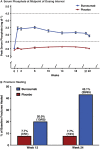Pharmacological management of X-linked hypophosphataemia
- PMID: 30207609
- PMCID: PMC6533442
- DOI: 10.1111/bcp.13763
Pharmacological management of X-linked hypophosphataemia
Abstract
The most common heritable disorder of renal phosphate wasting, X-linked hypophosphataemia (XLH), was discovered to be caused by inactivating mutations in the phosphate regulating gene with homology to endopeptidases on the X-chromosome (PHEX) gene in 1995. Although the exact molecular mechanisms by which PHEX mutations cause disturbed phosphate handling in XLH remain unknown, focus for novel therapies has more recently been based upon the finding that the bone-produced phosphaturic hormone fibroblast growth factor-23 is elevated in XLH patient plasma. Previous treatment strategies for XLH were based upon phosphate repletion plus active vitamin D analogues, which are difficult to manage, fail to address the primary pathogenesis of the disease, and can have deleterious side effects. A novel therapy for XLH directly targeting fibroblast growth factor-23 via a humanized monoclonal antibody (burosumab-twza/CRYSVITA, henceforth referred to just as burosumab) has emerged as an effective, and recently approved, pharmacological treatment for both children and adults. This review will provide an overview of the clinical manifestations of XLH, the molecular pathophysiology, and summarize its current treatment.
Keywords: PHEX; X-linked hypophosphataemia; burosumab-twza; fibroblast growth factor 23.
© 2018 The British Pharmacological Society.
Figures

Similar articles
-
Clinical practice recommendations for the diagnosis and management of X-linked hypophosphataemia.Nat Rev Nephrol. 2025 May;21(5):330-354. doi: 10.1038/s41581-024-00926-x. Epub 2025 Jan 15. Nat Rev Nephrol. 2025. PMID: 39814982 Review.
-
Safety and efficacy of burosumab in improving phosphate metabolism, bone health, and quality of life in adolescents with X-linked hypophosphatemic rickets.Eur J Med Genet. 2024 Aug;70:104958. doi: 10.1016/j.ejmg.2024.104958. Epub 2024 Jun 29. Eur J Med Genet. 2024. PMID: 38950880
-
X-Linked Hypophosphataemia and Burosumab: A Systemic Disease With a New Treatment.J Paediatr Child Health. 2025 May;61(5):685-700. doi: 10.1111/jpc.70015. Epub 2025 Feb 26. J Paediatr Child Health. 2025. PMID: 40012305 Free PMC article. Review.
-
Diagnosis, treatment-monitoring and follow-up of children and adolescents with X-linked hypophosphatemia (XLH).Metabolism. 2020 Feb;103S:153892. doi: 10.1016/j.metabol.2019.03.009. Epub 2019 Mar 27. Metabolism. 2020. PMID: 30928313 Review.
-
A Randomized, Double-Blind, Placebo-Controlled, Phase 3 Trial Evaluating the Efficacy of Burosumab, an Anti-FGF23 Antibody, in Adults With X-Linked Hypophosphatemia: Week 24 Primary Analysis.J Bone Miner Res. 2018 Aug;33(8):1383-1393. doi: 10.1002/jbmr.3475. Epub 2018 Jun 26. J Bone Miner Res. 2018. PMID: 29947083 Clinical Trial.
Cited by
-
X-Linked hypophosphatemia. Data from a Spanish adult population cohort.J Nephrol. 2024 Jun;37(5):1251-1260. doi: 10.1007/s40620-024-01962-3. Epub 2024 Jun 5. J Nephrol. 2024. PMID: 38837007
-
FGF23, Hypophosphatemia, and Emerging Treatments.JBMR Plus. 2019 May 13;3(8):e10190. doi: 10.1002/jbm4.10190. eCollection 2019 Aug. JBMR Plus. 2019. PMID: 31485552 Free PMC article. Review.
-
Osteocyte Vegf-a contributes to myeloma-associated angiogenesis and is regulated by Fgf23.Sci Rep. 2020 Oct 14;10(1):17319. doi: 10.1038/s41598-020-74352-x. Sci Rep. 2020. PMID: 33057033 Free PMC article.
-
Real-world non-interventional post-authorization safety study of long-term use of burosumab in children and adolescents with X-linked hypophosphatemia: first interim analysis.Ther Adv Chronic Dis. 2024 May 18;15:20406223241247643. doi: 10.1177/20406223241247643. eCollection 2024. Ther Adv Chronic Dis. 2024. PMID: 38764445 Free PMC article.
-
Current and Future Therapeutical Aspects of X-Linked Hypophosphatemia in Children With Special Attention to Klotho/Fibroblast Growth Factor 23 System.J Clin Med Res. 2022 Oct;14(10):436-439. doi: 10.14740/jocmr4820. Epub 2022 Oct 28. J Clin Med Res. 2022. PMID: 36406946 Free PMC article. No abstract available.
References
-
- Beck‐Nielsen SS, Brock‐Jacobsen B, Gram J, Brixen K, Jensen TK. Incidence and prevalence of nutritional and hereditary rickets in southern Denmark. Eur J Endocrinol 2009; 160: 491–497. - PubMed
-
- Hyp Consortium . A gene (PEX) with homologies to endopeptidases is mutated in patients with X‐linked hypophosphatemic rickets. The HYP consortium. Nat Genet 1995; 11: 130–136. - PubMed
-
- McNair SL, Stickler GB. Growth in familial hypophosphatemic vitamin‐D‐resistant rickets. N Engl J Med 1969; 281: 512–516. - PubMed
Publication types
MeSH terms
Substances
Grants and funding
LinkOut - more resources
Full Text Sources
Other Literature Sources

